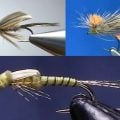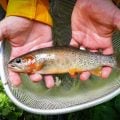How to Tie the Grizzy King
Producer: Tim Flagler
The Grizzly King is an ancient fly pattern, think England, early 1800’s. To me, what makes it so special, is its adaptability. It can be tied as a wet, a long-shanked streamer, a salmon fly, a tube fly and even as a dry – and all work. It’s got to be the unique combination of a green body and red tail along with black and white finely marked materials in the wing and throat.
This version of the Grizzly King begins with a Fulling Mill 5085 nymph hook in size 10. After getting the hook firmly secured in the jaws of my tying vise, I load a bobbin with a spool of black Veevus 10/0 thread. Get the thread started on the hook shank behind the eye and, after taking a few wraps rearward, snip off the excess tag. Continue taking thread wraps rearward to build up a thread base that extends all the way to the start of the hook bend.
Matching red duck quills are used to form the tail of the fly but just about anything red can be substituted if you like. Carefully strip equal-width segments from the two matching feathers, each should be a little more than 1/8” wide. Pick up the segment that has its tip pointing down and its concave side facing you. Lay the feather against the far side of the hook so it extends rearward, about a hook gap in length. Use a single pinch wrap to secure it to the top and far side of the hook.
Pick up the remaining segment and match it to the first on the near side of the hook, then take tight wraps of tying thread to secure it. Ideally, the two segments should form a nicely tented tail, but no worries if they don’t. Tails like this often get messed up way before the fly even hits the water. Anchor the butt ends to the hook shank with wraps of tying thread, stopping well short of the eye. Then snip the excess off close and take a few more thread wraps to really lock everything down.
Extra-small, gold/silver Mylar tinsel is used to rib and segment the fly. A 10” length will make numerous Grizzly Kings. Get hold of one end of the material, with the gold side facing you. Lay the end against the near side of the hook and take thread wraps to secure it, all the way back to the start of the bend. Then return your thread forward to the initial tie-in point. A hair clip will help to keep the curly Mylar out of the way on your tying vise. Pick up your whip finish tool and use it to do a 3 or 4 turn whip finish, seat the knot well then snip or cut your black tying thread free.
For the body of the fly, I prefer olive Uni-Stretch but you can certainly use floss, yarn or even dubbing. Get the Uni-Stretch started on the hook shank and, after taking a few wraps rearward, snip off the excess tag. Continue taking wraps to produce a somewhat ample, yet smooth body on the fly before anchoring the material with a whip finish and snipping it free.
Reestablish the black tying thread on the hook shank behind the eye. Once it’s secured, take 7 or 8 wraps, one on top of each other, you’ll see why in just a minute. You do need to have a rotary vise to do this. Anyway, rotate the vise to produce counter wraps with the Mylar over top of the green body. Now the silver side should face out. As you do this, notice that those extra thread wraps you put on are being unwound. When you reach your tying thread, use it to firmly anchor the Mylar then snip the excess off close. The fly should now look something like this.
The throat material is really up to you. To me, as long as it has black and white markings, you’re good to go. Here, I’m using a single grizzly saddle hackle. Strip off the lower, fuzzy fibers then gently preen down the lower webby fibers and snip the excess tip off. Lay the tip of the remaining segment against the near side of the hook and take tight thread wraps, like so, to secure it.
Get hold of the stem and gently preen the fibers rearward to either side of it, then begin wrapping to form a fairly sparse soft-hackle collar on the fly. With the collar formed, take wraps of tying thread to anchor the stem then snip the excess off close. Trim off any wayward fibers in the process. Press the fibers down on either side of the fly and take a few rearward thread wraps to hold them down.
For the wing of the fly, I really like barred, mallard flank feathers. From the side of the feather that has the longest fibers, strip off any of the lower fuzzy, curvy stuff. Then, coax 1/4” or so of fibers down, so their tips are aligned, and snip them free from the stem. While doing your best to keep the tips aligned, get hold of the butt ends of the fibers in the fingers of your right hand to collapse them into a clump. Measure to form a wing that extends about halfway down the tail of the fly, then use a few tight wraps of tying thread to anchor them on top of the fly. Don’t sweat it if the alignment isn’t perfect. The fly will still work just fine.
Using the angled hook eye as a guide, snip the excess butt ends of the fibers off close, being careful not to snip your tying thread in the process. A little fly tier’s wax added to your thread will give it a good bit more grip so when you start taking wraps to cover up the butt ends of the mallard, the wraps will have less of a tendency to slip. Once again, pick up your whip finish tool and use it to do a 5 or 6 turn, back to front, whip finish then seat the knot well and snip or cut your tying thread free. A drop of head cement applied to the wraps will help to ensure they don’t come unraveled and dress up the head of the fly as well.
Dead-drifted, swung or stripped, this version of the Grizzly King just plain works. Rather than getting caught up in why, probably best to simply fish it and enjoy the results.
How to Tie the Grenadier - Soft Hackle, Wet Fly Trout Pattern
How to Tie the Guide's Choice Hare's Ear











